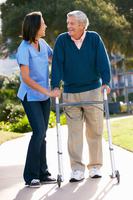 9th Aug 2012
9th Aug 2012
Monitoring Stroke Victims Performing Daily Life Tasks
A recent medical study suggests the traditional way of testing a stroke victim’s ability to complete daily life tasks may not be completely inaccurate. Traditionally, when a stroke victim is tested for his or her capacity to complete a daily task, the testing takes place in a hospital or rehabilitation clinic. The patient enters the clinic, gets hooked up to a

number of movement sensors and is asked to perform certain tasks by the doctor. The sensors then report on the functionality of the patient’s extremities (i.e. how much force the patient uses to push or pull, stand, sit, etc.). The report is then used to determine how much help may be needed for the patient when he or she returns home and has to deal with everyday tasks. The report can also be helpful in determining which muscle strength testing device might best help a patient. It can also be used to determine which muscle strengthening exercises a patient should use.
The rehabilitation process for people affected by strokes by involves more than running simple tests.
The problem with this method is it does not take into account that the amount of functional force a patient might exhibit in a clinic under controlled testing might not translate into performing actual daily activities. Taking out the trash, pulling the lever on a recliner, stepping into a bathtub, opening a door, etc. are very different from pushing against a doctor’s hand or picking up a weight in a clinic.
According to the study, the most accurate way of testing a stroke patient’s capacity to complete tasks is to put sensors on both patients and household objects. The study used radio frequency devices attached to both the patient and his or her household objects. When a patient came within 23 centimeters of a monitored object the sensor on both the patient and the object were triggered. For example, the test sought to determine the extent to which a stroke victim was actually using her right arm to perform daily household tasks. When the patient walked into the kitchen to get a cup of coffee off the counter the sensor was triggered. The radio frequency was able to determine which arm the patient used to pick up the cup of coffee. Under this form of testing, it can be determined what tasks the patient feels he or she is able to accomplish when alone in the home.





